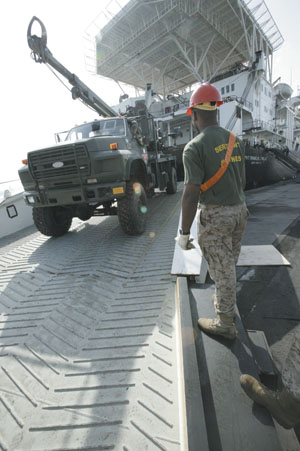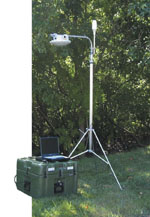Technology Tracks Casualties, Assets
 |
| The Early Entry Deployment Support Kit (EEDSK) can be deployed on supply ships to help track the delivery and distribution of equipment. |
The fusion of satellite communication, global positioning system and radio frequency identification tag technologies is giving the U.S. Marine Corps the ability to monitor the status of fallen comrades and battlefield assets. The Marines have several technology experiments underway that test the military’s In-Transit Visibility/Total Asset Visibility concept, which seeks to identify, locate and monitor personnel, equipment and supplies from origination to destination. As the defense community grapples with how to assess and implement the capabilities these evolving technologies generate, field tests indicate they will improve situational awareness while saving time, money, resources and lives.
One such effort focuses on providing consistent care and accountability for injured Marines. In late August, the Quantico, Virginia-based Marine Corps Warfighting Laboratory (MCWL) tested the Tactical Medical Coordination System (TacMedCS), a tracking system designed to assist U.S. Navy medical personnel with casualty evacuation and treatment reporting, according to Robert Williams, TacMedCS program manager, ScenPro Incorporated,
Web-enabled commanders and medical personnel can check the status and location of an RFID-tagged casualty by accessing a secure, Internet-based server. Follow-on medical attendants equipped with RFID scanners can read the casualty’s tag to obtain information about previous treatment and update the patient’s progress during recovery. Data updates are transmitted via satellite to a central database server. The RFID technology does not require contact between scanner and tag to access data, and neither clothing nor protective gear have to be removed.
The technology promises to ease the difficulty of accounting for a casualty’s continued care. “When corpsmen treat a casualty, they are absolutely responsible for that casualty until they know he’s at the next level of care,” says Williams, who worked with Navy medical personnel during TacMedCS’ initial field testing. Typically, he observes, corpsmen send runners or try to call to follow up on a casualty’s progress. “It’s a hard process,” Williams says. “Now we have one device that carries RFID read-and-write capability as well as the data-push through the Iridium modem.”
NAL Research Incorporated,
Comprising 66 satellites orbiting in six different planes, the Iridium constellation provides global transmission of data through a secured and dedicated
Linkowitz says that sending the data across satellites instead of down to terrestrial stations or other air- or space-borne assets owned by foreign governments or companies brings peace of mind. “We have concerns when data comes down in a foreign country and eventually is passed to our command post,” he explains.
As an expeditionary force, the Marine Corps often finds itself in places that have little or no infrastructure, so Iridium appears to be a good fit, Linkowitz says. “Iridium seemed to have very extensive coverage in those areas that we were concerned about,” he adds.
Bandwidth, however, is limited. At 2.4 kilobytes per second, the satellite connection speed cannot support the transfer of large files. “We’re not sending streaming video; we’re sending munitions reports and data fields that are always the same,” Linkowitz says. “It’s very fast, very efficient, and most importantly, it doesn’t tie up tactical communications networks, which are always at a premium.”
Medical reporting data also is a good candidate, Williams says. TacMedCS developers first experimented with transmitting data through dial-up service over a satellite telephone. “It was very slow,” he relates. Iridium then introduced short-burst data services that allow the user to send and receive small packets of data quickly while using very little battery power, which has increased transmission speeds. Short-burst technology allows the modem to power on and off very quickly to send roughly 70 to 100 bytes in less than a second across the satellite constellation. The application fits well with users facing power constraints or heightened security considerations.
Currently, Iridium offers short-burst data and consistent data transfer services in its bulky, multifunctional modem, nicknamed “the brick” because of its shape and size. Iridium officials say they will launch a trimmer, less expensive short-burst data device late this year. “It’s a short-burst data modem with a form factor of a PC card,” Scheimreif says. The original NAL Iridium modem has more capability, whereas the new 2-inch x 5-inch x 0.5-inch modem card will perform only short-burst data service, he adds. “From a military standpoint, if they need to outfit this on thousands and thousands of pieces out there, it will be more cost-effective.”
Terry Moores, deputy to the assistant chief of staff for logistics/engineering, G-4, U.S. Marine Corps Central Command in
The MCWL has set up a database to monitor the medical program so users can send data back to a government Web site, he adds. Short-burst data is a “way to get a small packet sent quickly and efficiently to wherever you’re sending it—whether it’s a server or another machine—to provide that visibility,”
 |
| Because the EEDSKs are lightweight and compact, they can be used to create a mobile interrogator site to track equipment, supplies and shipments. Data can be shared worldwide via the Iridium constellation, a capability that is important to the military when operating in areas that do not have the infrastructure to support land-based communications. |
In
As the Marine Corps’ resident logistics visionary, Linkowitz foresees a day soon when that same commander will be able to tell when one of his convoy vehicles is experiencing engine trouble long before it breaks down. Emerging sensor technology may give logisticians the ability to perform autonomic logistics, a term describing the ability to predict failure in operating systems, to monitor munitions inventory and to report pending failures without human intervention.
Autonomic logistics will benefit tactical operations, Linkowitz notes. If sensors monitoring the engine of a convoy truck start indicating that the transmission is going to fail within the next 100 miles or 10 hours, a warning is sent out via satellite to everyone affected by the impending failure. The unit’s mechanics can then deadline the vehicle while supply officials order a new transmission and convoy planners adjust vehicle assignments. In the past, something had to break before a new transmission was pulled, Linkowitz says.
New technology would enable preventative maintenance and also could save money. If units stationed in different parts of the world begin reporting similar transmission failures through a common logistics database via satellite, for example, the Marine Corps could hold the manufacturer accountable before the warranty expires, Linkowitz says. “Now we have a way to hold the manufacturer’s feet to the fire.”
Sensors can monitor engine temperature, fuel levels, munitions inventory and other operations and can distribute the results to all interested parties via satellite. The cumulative effect is the capability to sense logistics support requirements and respond to them in a timely fashion, Linkowitz points out. “It’s critical that logistics does not cause an operational pause,” he states.
The sense-and-respond environment these technologies enable is geared toward creating a common operational picture and greater situational awareness. Moores notes that the Marines are evaluating an RFID tag prototype called 3G that integrates RFID technology with GPS and satellite capabilities, which would allow commanders to locate content-level detail of any vehicle at any time, anywhere in the world. As with passive RFID tags, the 3G carries content-level information, but it also can use GPS and satellite capabilities to communicate actively with satellites and stationary RFID scanners or interrogators. These interrogators contain transmitters-receivers that read RFID tags and report the location and content data via satellite and GPS technology.
When interrogators are not nearby, the satellites continue to ping the tag to report its location through GPS technology. The 3G RFID tags are in early development but could give logisticians the ability not only to track vehicles but also to monitor the contents all along the route.
Once the equipment, supplies or vehicles arrive, Early Entry Deployment Support Kits (EEDSKs) can track inventory items as they are distributed to units. The EEDSKs are portable interrogators that can be set up quickly when equipment and supplies reach their destination. The Marine Corps is considering placing the kits on maritime prepositioning ships to replace the manual process of inventorying and distributing equipment as it is off-loaded, Linkowitz says. As soon as the ramp is dropped at the pier, the EEDSKs would be set up as a choke point. Information about equipment arrival and distribution could be transmitted to a common global logistics server via satellite that warfighters could access, and this data could be fed into a Web-based graphics program so that commanders with handheld or laptop computers could see where the vehicles are located on a real-time map.
The sea-based, land-encroaching Marine Corps needs situational awareness afloat and ashore, Linkowitz adds. He calls the new capabilities that integrate satellite transmission, GPS location, RFID data storage and tracking, and sensor technology an evolutionary leap. “It allows logistics to keep up with the Grunts,” Linkowitz states.
Web Resource
Marine Corps Warfighting Laboratory: www.mcwl.quantico.usmc.mil



Comments